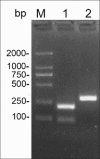Mitochondrial DNA Haplogroups and the Risk of Sporadic Parkinson's Disease in Han Chinese
- PMID: 26112715
- PMCID: PMC4733725
- DOI: 10.4103/0366-6999.159348
Mitochondrial DNA Haplogroups and the Risk of Sporadic Parkinson's Disease in Han Chinese
Abstract
Background: Mitochondrial dysfunction is linked to the pathogenesis of Parkinson's disease (PD). However, the precise role of mitochondrial DNA (mtDNA) variations is obscure. On the other hand, mtDNA haplogroups have been inconsistently reported to modify the risk of PD among different population. Here, we try to explore the relationship between mtDNA haplogroups and sporadic PD in a Han Chinese population.
Methods: Nine single-nucleotide polymorphisms, which define the major Asian mtDNA haplogroups (A, B, C, D, F, G), were detected via polymerase chain reaction-restriction fragment length polymorphism or denaturing polyacrylamide gel electrophoresis in 279 sporadic PD patients and 510 matched controls of Han population.
Results: Overall, the distribution of mtDNA haplogroups did not show any significant differences between patients and controls. However, after stratification by age at onset, the frequency of haplogroup B was significantly lower in patients with early-onset PD (EOPD) compared to the controls (odds ratio [OR] =0.225, 95% confidence interval [CI]: 0.082-0.619, P = 0.004), while other haplogroups did not show significant differences. After stratification by age at examination, among subjects younger than 50 years of age: Haplogroup B also showed a lower frequency in PD cases (OR = 0.146, 95% CI: 0.030-0.715, P = 0.018) while haplogroup D presented a higher risk of PD (OR = 3.579, 95% CI: 1.112-11.523, P = 0.033), other haplogroups also did not show significant differences in the group.
Conclusions: Our study indicates that haplogroup B might confer a lower risk for EOPD and people younger than 50 years in Han Chinese, while haplogroup D probably lead a higher risk of PD in people younger than 50 years of age. In brief, particular Asian mtDNA haplogroups likely play a role in the pathogenesis of PD among Han Chinese.
Conflict of interest statement
Figures




References
-
- Zhang ZX, Roman GC, Hong Z, Wu CB, Qu QM, Huang JB, et al. Parkinson's disease in China: Prevalence in Beijing, Xian, and Shanghai. Lancet. 2005;365:595–7. - PubMed
-
- Thomas B, Beal MF. Parkinson's disease. Hum Mol Genet. 2007;16 Spec No 2:R183–94. - PubMed
-
- Nicklas WJ, Youngster SK, Kindt MV, Heikkila RE. MPTP, MPP+ and mitochondrial function. Life Sci. 1987;40:721–9. - PubMed
-
- Parker WD, Jr, Boyson SJ, Parks JK. Abnormalities of the electron transport chain in idiopathic Parkinson's disease. Ann Neurol. 1989;26:719–23. - PubMed
-
- Schapira AH, Cooper JM, Dexter D, Jenner P, Clark JB, Marsden CD. Mitochondrial complex I deficiency in Parkinson's disease. Lancet. 1989;1:1269. - PubMed
MeSH terms
Substances
LinkOut - more resources
Full Text Sources
Other Literature Sources
Medical

